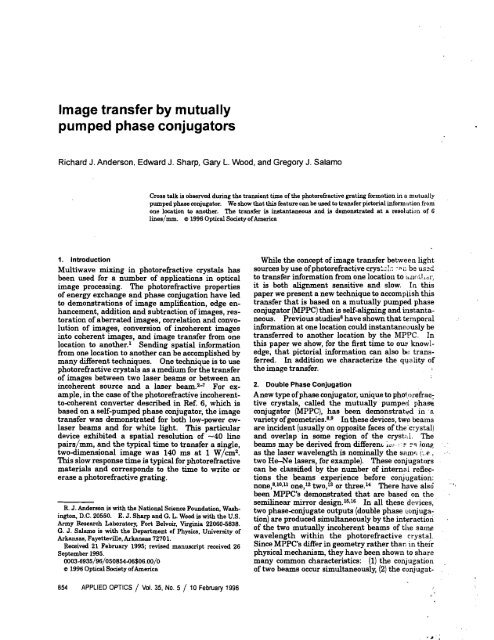Three - University of Arkansas Physics Department
Three - University of Arkansas Physics Department
Three - University of Arkansas Physics Department
You also want an ePaper? Increase the reach of your titles
YUMPU automatically turns print PDFs into web optimized ePapers that Google loves.
Image transfer by mutually<br />
pumped phase conjugators<br />
Richard J. Anderson, Edward J. Sharp, Gary L. Wood, and Gregory J. Salamo<br />
Cross talk is observed during the transient time <strong>of</strong> the photorefiactive grating formation in a mutually<br />
pumped phase conjugator. We show that this feature can be used to transfer pictorial information from<br />
one location to another. The transfer is instantaneous and is demonstrated at a resolution <strong>of</strong> 6<br />
lines/mm. 0 1996 Optical Society <strong>of</strong>America<br />
1. Introduction<br />
Multiwave mixing in photorefractive crystals has<br />
been used for a number <strong>of</strong> applications in optical<br />
image processing. The photorefractive properties<br />
<strong>of</strong> energy exchange and phase conjugation have led<br />
to demonstrations <strong>of</strong> image amplification, edge enhancement,<br />
addition and subtraction <strong>of</strong> images, restoration<br />
<strong>of</strong> aberrated images, correlation and convolution<br />
<strong>of</strong> images, conversion <strong>of</strong> incoherent images<br />
into coherent images, and image transfer from one<br />
location to another.' Sending spatial information<br />
from one location to another can be accomplished by<br />
many different techniques. One technique is to use<br />
photorefractive crystals as a medium for the transfer<br />
<strong>of</strong> images between two laser beams or between an<br />
incoherent source and a laser beam.%' For example,<br />
in the case <strong>of</strong> the photorefractive incoherenttocoherent<br />
converter described in Ref. 6, which is<br />
based on a self-pumped phase conjugator, the image<br />
transfer was demonstrated for both low-power cwlaser<br />
beams and for white light. This particular<br />
device exhibited a spatial resolution <strong>of</strong> -40 line<br />
pairs/mm, and the typical time to transfer a single,<br />
two-dimensional image was 140 ms at 1 ~/cm2.<br />
This slow response time is typical for photorefractive<br />
materials and corresponds to the time to write or<br />
erase a photorefractive grating.<br />
R. J. Anderson is with the National Science Foundation, Washington,<br />
D.C. 20550. E. J. Sharp and G. L. Wood is with the U.S.<br />
Army Research Laboratory, Fort Belvoir, Virginia 220604838.<br />
G. J. Salamo is with the <strong>Department</strong> <strong>of</strong> <strong>Physics</strong>, <strong>University</strong> <strong>of</strong><br />
<strong>Arkansas</strong>, Fayetteville, <strong>Arkansas</strong> 72701.<br />
Received 21 February 1995; revised manuscript received 26<br />
September 1995.<br />
0003-6935/96/050854-06$06.00/0<br />
o 1996 Optical Society <strong>of</strong>America<br />
854 APPLIED OPTICS / Vol. 35, No. 5 / 10 February 1996<br />
While the concept <strong>of</strong> image transfer between light<br />
sources by use <strong>of</strong>photorefractive crys:.:!; -nc be us22<br />
to transfer information from one locatiozi to ~i~ltl,;~;<br />
it is both alignment sensitive and slow. In this<br />
paper we present a new technique to accomplish this<br />
transfer that is based on a mutually pumped phase<br />
conjugator (MPPC) that is self-aligning and instantaneous.<br />
Previous studiess have shown that temporal<br />
information at one location could instantaneously be<br />
transferred to another location by the MPPC. In<br />
this paper we show, for the first time to our knowledge,<br />
that pictorial information can also bt: transferred.<br />
In addition we characterize the quality <strong>of</strong><br />
the image transfer.<br />
2. Double Phase Conjugation<br />
Anew type <strong>of</strong> phase conjugator, unique to phol orefrao:<br />
tive crystals, called the mutually pumped phase<br />
conjugator (MPPC), has been demonstratvd in a<br />
variety <strong>of</strong> geometrie~.~~~ In these devices, two beams<br />
are incident (usually on opposite faces <strong>of</strong> the crystal)<br />
and overlap in some region <strong>of</strong> the cryst:,l. The<br />
beams may be derived from differ en^ LC!- - n 9 iong<br />
*<br />
as the laser wavelength is nominally the Sam.: (;.e, two He-Ne lasers, for example). These conjugators<br />
can be classified by the number <strong>of</strong> internal reflections<br />
the beams experience before conjugation:<br />
n~ne,~J~Jl one,12 two,13 or three.14 There have alsd<br />
been MPPC's demonstrated that are based on the<br />
semilinear mirror design.16J6 In all these devices,<br />
two phaeeconjugate outputs (double phase conjugation)<br />
are produced simultaneously by the interaction<br />
<strong>of</strong> the two mutually incoherent beams <strong>of</strong> the same<br />
wavelength within the photorefractive crystal.<br />
Since MPPC's differ in geometry rather than In their<br />
physical mechanism, they have been shown to share<br />
many common characteristics: (1) the conjugation<br />
<strong>of</strong> two beams occur simultaneously, (2) the conjugat-<br />
'













